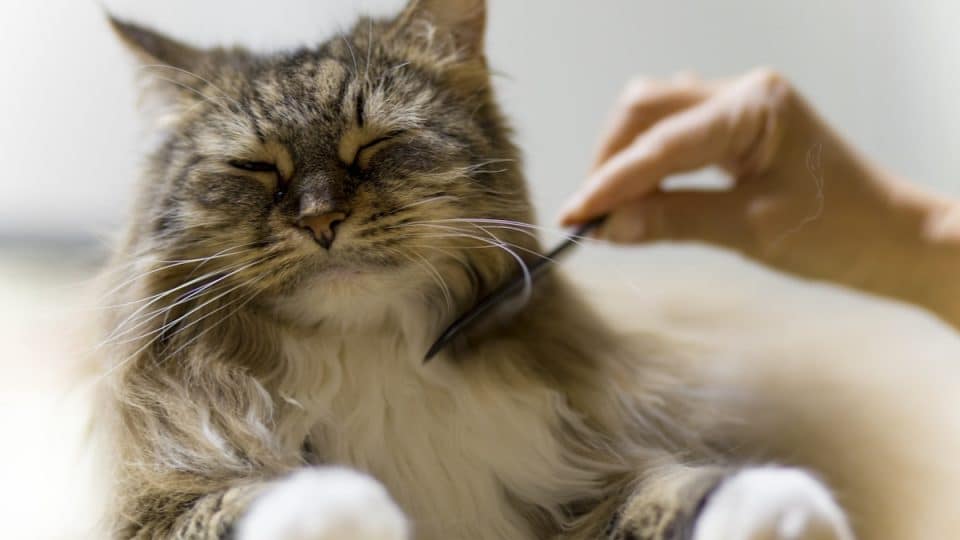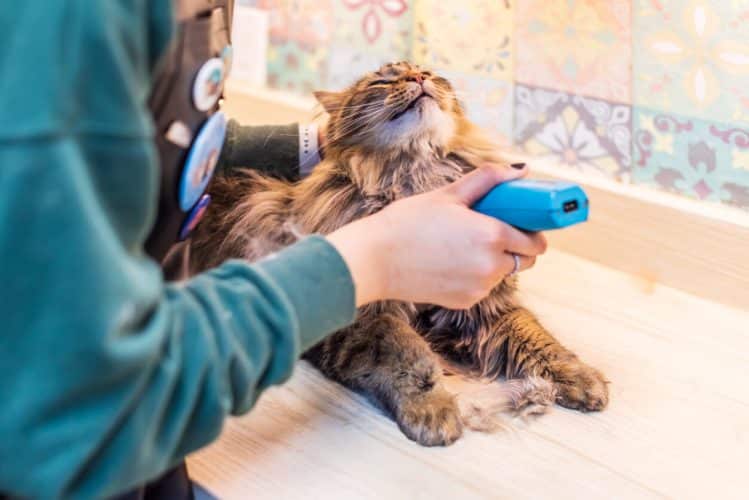- This post contains affiliate links. Read more here.
- Not a substitute for professional veterinary help.
From Persians to Maine Coons, cats boast a variety of beautiful coats. And the more beautiful the coat, the more maintenance it can require. Without proper grooming, cat hair can become tangled and matted, causing your pet discomfort and increasing their risk of skin irritation, infection, and other health issues.
We asked Scott M. Rovner, founder and lead veterinarian at Roscoe Village Animal Hospital in Chicago, how to fix and prevent matted fur—from treating tangles to keeping their stunning coat healthy.
What Does Matted Cat Hair Look Like?
“Cats are recognized as fastidious and hygienic animals, known to maintain their coat’s cleanliness diligently,” explains Dr. Rovner. Without sufficient grooming, however, dirt and oils from a cat’s skin can cause hair to clump together in tightly tangled knots that can be difficult to smooth.
If you start to notice tufts of fur amid your cat’s silky coat, that’s a sign that there may be matting. Matted fur can range from very mild tangles easily remedied at home to extreme cases that require the pet’s coat to be completely shaved.
How do you judge the severity of matting?
According to Dr. Rovner, mats that become sizable and begin tugging at the cat’s skin warrant a trip to the vet or a visit to a professional groomer. Large knots are usually too difficult to comb out at home—and they’re also a hazard to the pet. Severe matting causes discomfort and can lead to inflammation, skin sores, and infection, so it’s important to treat right away.
Less severe matting usually takes the form of tangles. These can typically be treated at home and should be fixed promptly before the matting worsens.
And don’t assume just because your cat has short fur that they can’t get mats. While long-haired cats are most prone to matting, their short-haired counterparts also require diligent grooming. Without the proper care, short coats can also begin to tangle and knot due to the buildup of dirt and oils.
How To Remove Mild Matting
If your kitty has a clump or two in their otherwise pristine coat, fear not! This usually isn’t something to worry about. Mild matting can be treated at home—though you’ll want to act promptly before any knots worsen.
A comb and some all-natural cat detangler (or conditioner if you’re braving a bath) will typically do the trick for small amounts of matting. “It is imperative to utilize a fine-tooth comb, such as a flea comb, to disentangle knots delicately,” says Dr. Rovner. “Scissors should never be employed for mat removal due to the inherent risk of lacerating the cat’s skin.”
As you gently comb out mats, take special care not to tug at the skin. This is always the best at-home remedy for removing matted cat hair without the dangers of cutting off clumps of fur. Rewarding kitty with treats can help make things easier too!
How To Remove Moderate Matting
If your cat’s coat becomes moderately matted, it’s time to call in the professionals. Moderate matting is possible in short and long-haired cats and can be difficult for the average pet parent to fix at home.
If a clump of fur feels too large or mats are beyond treatable with a fine-tooth comb, it’s a good idea to find an experienced pet groomer who can help restore your feline’s coat to good health. You can also contact your vet for advice on the next steps.
While it can be tempting to try and remove difficult matting yourself, avoid cutting knots from the fur or forcing a brush through dense tangles.
How To Remove Severe Matting
A severely matted cat (especially of the medium or long-hair variety) requires professional assistance. If your cat’s fur has serious mats, it’s important to act quickly. Start by booking a visit to your vet—they will be able to help identify the reason your cat is struggling with grooming and best determine how to safely remove mats.
At-home remedies aren’t the right fit for severe matting, as an expert will often need to shave the coat to remove large tangles. Since shaving can be stressful for a pet, it’s best to leave this method to the professionals. Avoid cutting, combing, or tugging at knots, as it can further irritate the skin.
Why It’s Important To Treat Mats Quickly
Matted fur isn’t just a bad hair day. It can also have an impact on your cat’s quality of life. “Matted fur can be very painful if the mats are large enough or tight enough to the skin,” Dr. Carter says. “Even after the mats are removed, there can be irritation or sores on the skin.”
Left unchecked, chronic matting in pets could also contribute to health problems, including:
- Skin irritation and infections
- Parasitic infestations
- Chronic ear or eye infections
- Constipation or impaction
How To Prevent Matted Cat Hair
While dealing with mats can be a nuisance for you and your kitty, matting is highly preventable. The best way to prevent mats is to make brushing a regular part of your routine.
The American Society for the Prevention of Cruelty to Animals (ASPCA) recommends brushing your cat once or twice weekly to prevent matting and remove dirt, grease, and dead skin/hair from the fur. Regular brushings are especially beneficial for older cats who no longer groom themselves as meticulously. This practice also helps stimulate healthy blood circulation.
Cats with longer coats who aren’t a fan of brushing might require a visit to a professional groomer every few weeks. Visiting a groomer will keep your feline’s fur clean and healthy and assist with other hygienic practices that can be difficult at home—such as ear cleaning, toothbrushing, and nail trimming.
Why does matting happen?
Some cats are more susceptible than others to matting. According to Dr. Amber Carter, board-certified feline veterinarian and owner of CatVetLife, several factors can play a role in matted fur:
- Age. Older cats may have joint conditions, like arthritis, which can make it harder to groom themselves properly.
- Fur Length. Long-haired cat breeds, like Maine Coons, are more prone to matting than their short-haired counterparts. (However, short-haired cats can also experience matting!)
- Weight. Overweight or obese cats may have a tougher time bending to groom certain spots on their body, like the area around their tails.
- Illnesses. Sick cats often have less energy, which often means they’re less likely to groom themselves. Cats with dental diseases may also lose interest in grooming due to the discomfort in their mouth—which is, of course, their main grooming tool.
If your cat falls into one of these groups, it’s a good idea to make prevention—daily brushing and detangling—a priority.





